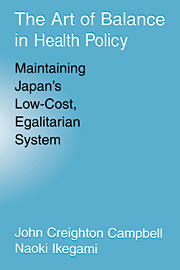Book contents
- Frontmatter
- Contents
- List of Tables and Figures
- Preface
- 1 Low Health-Care Spending in Japan
- 2 Actors, Arenas, and Agendas in Health Policy Making
- 3 Health-Care Providers
- 4 The Egalitarian Health Insurance System
- 5 The Macropolicy of Cost Containment
- 6 The Micropolicy of Cost Containment
- 7 The Quality Problem
- 8 Lessons?
- Index
1 - Low Health-Care Spending in Japan
Published online by Cambridge University Press: 07 October 2011
- Frontmatter
- Contents
- List of Tables and Figures
- Preface
- 1 Low Health-Care Spending in Japan
- 2 Actors, Arenas, and Agendas in Health Policy Making
- 3 Health-Care Providers
- 4 The Egalitarian Health Insurance System
- 5 The Macropolicy of Cost Containment
- 6 The Micropolicy of Cost Containment
- 7 The Quality Problem
- 8 Lessons?
- Index
Summary
IT is remarkable, in all the discussion of health-care reform in recent years, that so few Americans are aware of this very simple and vital fact: Every other industrialized nation in the world spends much less on health care than does the United States, even though each provides universal health coverage. Every characteristic on the following list is true of Japan and of a clear majority of Organization for Economic Cooperation and Development (OECD) nations; none is true of the United States:
Virtually the entire population is included in mandatory health insurance.
Most enrollment is automatic with little choice of coverage for either consumers or insurers.
The benefit package in all programs covers nearly all regular health care.
Payment for health insurance is largely determined by ability to pay, through contributions as a share of income.
Differences in burdens across social groups are reduced by such mechanisms as support from general revenue and cross-subsidization among insurance plans.
Nearly all prices are strictly controlled by a fee schedule.
The fee schedule is periodically renegotiated between insurers and providers.
Spending that is not directly related to health care, such as medical research and administrative expenses for insurers and providers, is kept quite low.
Total health-care spending is tracked and controlled, at least indirectly.
“Ah, but the United States is a different kind of country,” comes the response.
- Type
- Chapter
- Information
- The Art of Balance in Health PolicyMaintaining Japan's Low-Cost, Egalitarian System, pp. 1 - 20Publisher: Cambridge University PressPrint publication year: 1998

